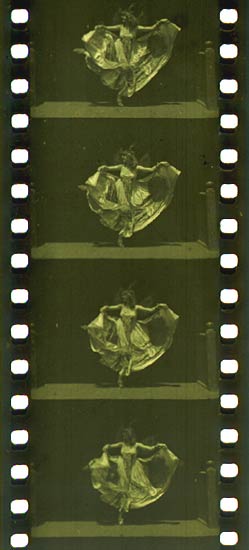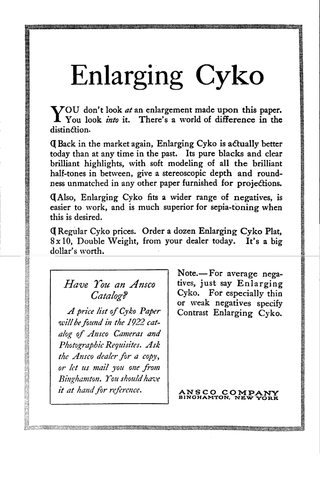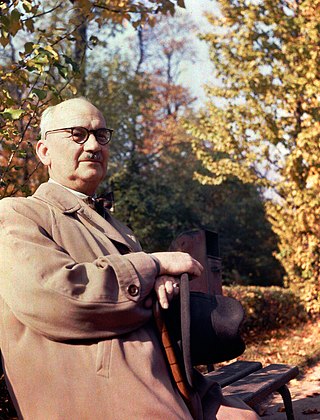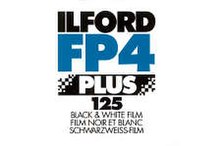
Film stock is an analog medium that is used for recording motion pictures or animation. It is recorded on by a movie camera, developed, edited, and projected onto a screen using a movie projector. It is a strip or sheet of transparent plastic film base coated on one side with a gelatin emulsion containing microscopically small light-sensitive silver halide crystals. The sizes and other characteristics of the crystals determine the sensitivity, contrast and resolution of the film. The emulsion will gradually darken if left exposed to light, but the process is too slow and incomplete to be of any practical use. Instead, a very short exposure to the image formed by a camera lens is used to produce only a very slight chemical change, proportional to the amount of light absorbed by each crystal. This creates an invisible latent image in the emulsion, which can be chemically developed into a visible photograph. In addition to visible light, all films are sensitive to X-rays and high-energy particles. Most are at least slightly sensitive to invisible ultraviolet (UV) light. Some special-purpose films are sensitive into the infrared (IR) region of the spectrum.

Photographic paper is a paper coated with a light-sensitive chemical, used for making photographic prints. When photographic paper is exposed to light, it captures a latent image that is then developed to form a visible image; with most papers the image density from exposure can be sufficient to not require further development, aside from fixing and clearing, though latent exposure is also usually present. The light-sensitive layer of the paper is called the emulsion, and functions similarly to photographic film. The most common chemistry used is gelatin silver, but other alternatives have also been used.

In photography, reversal film or slide film is a type of photographic film that produces a positive image on a transparent base. Instead of negatives and prints, reversal film is processed to produce transparencies or diapositives. Reversal film is produced in various sizes, from 35 mm to roll film to 8×10 inch sheet film.

The gelatin silver process is the most commonly used chemical process in black-and-white photography, and is the fundamental chemical process for modern analog color photography. As such, films and printing papers available for analog photography rarely rely on any other chemical process to record an image. A suspension of silver salts in gelatin is coated onto a support such as glass, flexible plastic or film, baryta paper, or resin-coated paper. These light-sensitive materials are stable under normal keeping conditions and are able to be exposed and processed even many years after their manufacture. The "dry plate" gelatin process was an improvement on the collodion wet-plate process dominant from the 1850s–1880s, which had to be exposed and developed immediately after coating.
C-41 is a chromogenic color print film developing process introduced by Kodak in 1972, superseding the C-22 process. C-41, also known as CN-16 by Fuji, CNK-4 by Konica, and AP-70 by AGFA, is the most popular film process in use, with most, if not all photofinishing labs devoting at least one machine to this development process.

In infrared photography, the photographic film or image sensor used is sensitive to infrared light. The part of the spectrum used is referred to as near-infrared to distinguish it from far-infrared, which is the domain of thermal imaging. Wavelengths used for photography range from about 700 nm to about 900 nm. Film is usually sensitive to visible light too, so an infrared-passing filter is used; this lets infrared (IR) light pass through to the camera, but blocks all or most of the visible light spectrum; these filters thus look black (opaque) or deep red.

Technical Pan is an almost panchromatic black-and-white film that was produced by Kodak. While it can reproduce the visible light spectrum, it leans to the red, and so unfiltered outdoor shots render blues, most notably the sky, with additional darkening and reds with some lightening. It was generally used as a very slow film, rated at EI 25 or even 16, although it could be rated at up to EI 320 with a distinct loss of tonal range and a bunching of shadow and highlight detail. This film has unmatched fine grain, especially when rated at a low speed, and makes excellent enlargements while preserving fine details. Kodak stopped selling it in 2004. It has not been replaced by a film with its characteristics. Although some of its particularities were unique and no emulsion in actual production could replace it, its resolution capabilities were surpassed by another film by ADOX, CMS 20 II.
Ilfochrome is a dye destruction positive-to-positive photographic process used for the reproduction of film transparencies on photographic paper. The prints are made on a dimensionally stable polyester base as opposed to traditional paper base. Since it uses 13 layers of azo dyes sealed in a polyester base, the print will not fade, discolour, or deteriorate for an extended time. Accelerated aging tests conducted by Henry Wilhelm rated the process as producing prints which, framed under glass, would last for 29 years before color shifts could be detected. Characteristics of Ilfochrome prints are image clarity, color purity, and being an archival process able to produce critical accuracy to the original transparency.

The ADOX brand for photographic purposes has been used by three different companies since its original conception over one hundred fifty years ago. ADOX was originally a brand name used by the German company, Fotowerke Dr. C. Schleussner GmbH of Frankfurt am Main, the world's first photographic materials manufacturer. In 1962 the Schleussner family sold its photographic holdings to DuPont, an American company. DuPont used the brand for its subsidiary, Sterling Diagnostic Imaging for X-ray films. In 1999, Sterling was bought by the German company Agfa. Agfa did not use the brand and allowed its registration to lapse in 2003. Fotoimpex of Berlin, Germany, a company founded in 1992 to import photographic films and papers from former eastern Europe immediately registered the brand and today ADOX is a brand of black and white films, photographic papers and photochemistry produced by ADOX Fotowerke GmbH based in Bad Saarow near Berlin.

Harman Technology Limited, trading as Ilford Photo, is a UK-based manufacturer of photographic materials known worldwide for its Ilford branded black-and-white film, papers and chemicals and other analog photography supplies. Historically it also published the Ilford Manual of Photography, a comprehensive manual of everything photographic, including the optics, physics and chemistry of photography, along with recipes for many developers.

Analog photography, also known as film photography, is a term usually applied to photography that uses chemical processes to capture an image, typically on paper, film or a hard plate. These processes were the only methods available to photographers for more than a century prior to the invention of digital photography, which uses electronic sensors to record images to digital media. Analog electronic photography was sometimes used in the late 20th century but soon died out.

Dufaycolor is an early British additive colour photographic film process, introduced for motion picture use in 1932 and for still photography in 1935. It was derived from Louis Dufay's Dioptichrome plates, a glass-based product for colour still photography, introduced in France in 1909. Both Dioptichrome and Dufaycolor worked on the same principles as the Autochrome process, but achieved their results using a layer of tiny colour filter elements arrayed in a regular geometric pattern, unlike Autochrome's random array of coloured starch grains. The manufacture of Dufaycolor film ended in the late 1950s.
The merits of digital versus film photography were considered by photographers and filmmakers in the early 21st century after consumer digital cameras became widely available. Digital photography and digital cinematography have both advantages and disadvantages relative to still film and motion picture film photography. In the 21st century, photography came to be predominantly digital, but traditional photochemical methods continue to serve many users and applications.

Fujicolor Superia is a Fujifilm brand of daylight balanced colour negative film introduced ca.1998 primarily aimed at the consumer market, but was also sold in a professional 'press' variant. A key feature at launch was the '4th' cyan colour layer designed to provide improved colour reproduction under fluorescent lighting. Its Kodak equivalent is the Kodacolor Gold/Ultramax line.
Fujicolor Pro was a line of professional color negative films from Japanese company Fujifilm introduced in 2004 for weddings, portraits, fashion and commercial photography. It originally comprised four emulsions: Pro 160S, Pro 160C, Pro 400H and Pro 800Z. Its main competitor was Kodak Portra.

Photographic film is a strip or sheet of transparent film base coated on one side with a gelatin emulsion containing microscopically small light-sensitive silver halide crystals. The sizes and other characteristics of the crystals determine the sensitivity, contrast, and resolution of the film. Film is typically segmented in frames, that give rise to separate photographs.

Neopan was originally a family of black-and-white films from Japanese manufacturer Fujifilm for both professional and amateur use. The range now only comprises one film; Neopan ACROS 100 II, a traditional silver halide black and white film re-launched in 2019 and currently sold worldwide.

Kodak High-Speed Infrared film, also known as Kodak HIE, was a popular black-and-white infrared photographic film from Kodak. The film was sensitive to the visible light spectrum, infrared radiation up to 900nm in wavelength, and some ultraviolet radiation as well.















